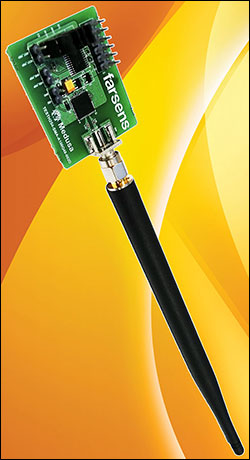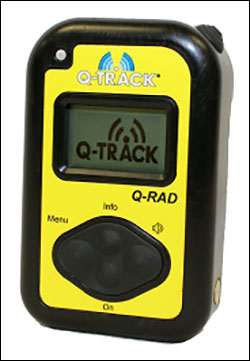The following are news announcements made during the past week by the following organizations:
Farsens;
BeaconStream;
Q-Track;
ThingMagic;
Bluvision, Texas Instruments;
Honeywell and Datamax-O’Neil.
Farsens Unveils Development Platform for Battery-Free Wireless Sensors, Actuators
Farsens, a Spanish developer of RFID sensor tags, has unveiled the Medusa, a platform designed for developers that want to create ultrahigh-frequency (UHF) RFID battery-free sensors and actuators. The Medusa harvests energy from the RF field created by the RFID reader to power up the chip, the microcontroller, and the circuitry and devices attached to it. According to Farsens, the RFID interface is compatible with commercial UHF RFID readers that support EPC Gen 2.
The Medusa includes Farsens’ ANDY100 chip and a MSPG2233IPW20 general-purpose, low-power microcontroller from Texas Instruments. The ANDY100 chip works under standard EPC Gen 2 commands, using any standards-based UHF RFID reader, so no proprietary or custom commands are needed.
The ANDY100 IC includes an RF front end for UHF RFID power harvesting and communication, a power supply module to generate the required voltage levels, and an SPI master module. In order to isolate the supply of the RFID tag from the supply of the rest of the system, the diode D1 is included. A voltage monitor is also included, to connect the microcontroller only after the energy storage capacitor has been charged. The voltage monitor connects the microcontroller when the charge in the capacitor exceeds 2.4 volts, and disconnects it when the charge falls below 1.8 volts. This architecture avoids oscillation of the system during the startup.
With a 2-watt ERP setup, the battery-less Medusa tag can communicate with a reader located up to 1.5 meters (5 feet) away, though the actual distance depends on the firmware downloaded to the microcontroller and the activities it performs, Farsens reports. It is available with a standard SMA connector, so that different antennas can be tested. The Medusa features 2 kilobytes of Flash memory, 256 bits of SRAM and 96 bits of Electronic Product Code (EPC) memory, and has an operating temperature of -30 degrees to +85 degrees Celsius (-22 degrees to +185 degrees Fahrenheit).
BeaconStream Updates Bluetooth Beacons, Software
BeaconStream has announced new software tools and a Bluetooth beacon device based on Apple‘s iBeacon specifications that is designed to provide enterprises with a fully operational beacon network and a branded mobile app within just a few hours.
The solution includes a free mobile software development kit (SDK) that companies can use to build a mobile app using either the iOS or Android platform. It allows app developers to add new location-awareness revenue streams to existing platforms, and offers retailers the ability to provide their mobile customers with a new shopping experience involving very limited steps. BeaconStream also offers management software that enables remote configuration and management, enterprise-grade security, and rich analysis of data in real time for an entire beacon network.
The beacons, SDK and management software were first piloted earlier this year. Since then, BeaconStream has updated the products. The new product set provides better beacons, a more user-friendly mobile application, a cloud-based Web management portal, and an improved SDK, according to Chris Damron, BeaconStream’s CIO.
Specifically, the free Business Mobile App is much more user-friendly, features loyalty points, requires no training, and can be used for monitoring campaigns on the go and managing beacons within range. The newly designed beacons have an on/off switch and a light indicating that the battery is charged, so users can determine that it is actually working, and BeaconStream also built it with a USB rechargeable battery port that enables firmware updates. The beacon measures 3 inches in diameter and is durable enough to withstand harsh conditions. With a form factor that includes a detachable clip, BeaconStream’s beacon can be clipped to a belt or attached to an asset. The beacon is available in multiple colors, and prices range from $150 for a quantity of three to $400 for a quantity of 10.
To provide even greater control over a fleet of beacons located anywhere in the world, BeaconStream offers a cloud-based Web console to create, save, stream and monitor multiple customized digital content and campaigns. Easy-to-use marketing campaign templates leave retailers free to focus on building great consumer experiences and deriving value from the network, Damron says. “The Web management portal is robust enough to handle every sized business, from a small mom-and-pop business to a large scale multi-location corporation,” he states. “The Web portal allows users to manage multiple beacons, multiple locations and analytics, as well as view the battery life of every deployed beacon.”
According to Damron, the SDK lets developers register, communicate, create campaigns and manage beacons within a couple of hours, without knowing much about the technology.
BeaconStream’s entire solution. from physical beacons to the software interface, can customized and developed for enterprises seeking custom branding, the company reports. Innovative Dining Group is leveraging BeaconStream’s end-to-end iBeacon solution to drive consumers into its venues via location-based offers, BeaconStream reports.
Q-Track Launches New RTLS-Enabled Tool for Emergency Responder Radiation Training
Q-Track Corp. has announced the Q-Rad Dosimulator, a new tool designed to provide greater realism and fidelity in emergency responder radiation training for military, homeland security, defense, customs, first-responders and nuclear personnel.
Q-Rad employs real-time location system (RTLS) technology to track simulated radiation sources, and to simulate a radiation dosimeter (dosimeters are devices that measure exposure to ionizing radiation). The resulting “dosimulation” system emulates the behavior of real sources and dosimeters, and thus can help train emergency responders and teach how long they can remain in a specific radioactive environment before jeopardizing their health. According to Q-Track, the system provides a valuable training tool for emergency responders and other workers who must perform essential duties while avoiding unnecessary radiation exposure.
The RTLS, built on Q-Track’s patented Near Field Electromagnetic Ranging technology, employs low-frequency, long-wavelength signals to achieve accurate location information in challenging environments as often encountered by emergency responders, Q-Track says. The company’s tags are battery-powered and employ a proprietary air-interface protocol to communicate with a receiver.
The first use of the Q-Rad Dosimulator is at the Nuclear and Radiological Training Center in Oak Ridge, Tenn., which provides response training for radiological events and an opportunity for security forces, as well as health and public-safety personnel.
Q-Track tested early versions of an RTLS-enabled tool for training responses to radiation events with Southern Co., as part of a simulated environment intended to train future employees of the electric utility company’s Plant Vogtle nuclear facility, located in Waynesboro, Ga. (see Nuclear Plant Operator Uses RFID to Promote Safety).
ThingMagic Firmware Simplifies RFID-enabled Product Development
Trimble has announced an update to its ThingMagic Micro and Micro-LTE embedded UHF RFID modules in the ThingMagic Mercury 6e Series of EPC Gen 2 RFID-embedded reader modules. The firmware update is designed to allow for autonomous operation, by enabling hardware read triggers and savable configuration settings in the module. It minimizes configuration, eliminates the need for users to write and run ThingMagic’s MercuryAPI development code, and simplifies the process of building RFID-enabled products, according to Trimble.
Currently, customers using the Micro and Micro-LTE modules in their existing RFID products need to use the MercuryAPI (which supports Java, .NET and C programming environments) to write applications to control the module. The MercuryAPI Software Development Kit (SDK) contains sample applications and source code to help developers get started. With the firmware update, users can now save configuration settings, such as RF power, duty cycle, read triggers and which antennas to search on. This, Trimble reports, allows individuals who have not previously used ThingMagic modules and written code to the MercuryAPI to build RFID finished readers more easily.
In addition, the Micro and Micro-LTE modules can now be configured to start reading and outputting tag data on power-up or on change-of-state of a general purpose input (GPI) line. The new saved settings options can be configured using the MercuryAPI or the new Autonomous Configuration Tool.
The Micro and Micro-LTE modules with autonomous operation are suitable for prospects who have an existing platform unable to accommodate the use of the MercuryAPI, but who want to implement an RFID solution, according to Trimble. Additionally, this mode of operation results in decreased power consumption, the company notes, because the “read on power up” mode allows the reader to consume power only when it is activated. There is no power consumption if the device is deactivated, Trimble adds, making it a good solution for a battery-operated device, such as a handheld reader.
The Micro and Micro-LTE module firmware update is available now.
Bluvision’s iBEEK Beacon Products Feature TI’s Wi-Fi and Bluetooth Smart Solutions
Bluvision, a provider of enterprise Bluetooth solutions, has announced that its Bluetooth beacon product line uses Texas Instruments‘ SimpleLink Wi-Fi and Bluetooth Smart solutions. Bluvision’s iBEEK beacons are designed for large deployments and long-term enterprise use, with battery life of up to three years running on Apple‘s iBeacon mode and incorporating multiple real-time sensors—including temperature, light and motion, according to Bluvision.
Multiple iBEEKs can connect to BluFi, Bluvision’s Bluetooth-to-Wi-Fi gateway that enables remote Beacon monitoring and cloud alerts via Bluetooth. With built-in Wi-Fi, BluFi bridges communication from any iBEEK with its built-in sensors to its cloud-management platform, thereby enabling connectivity across an organization.
Bluvision supplied Bluetooth beacons as part of an American Airlines trial in Dallas. In addition, at Miami International Airport, BluVision has installed its BluFi device, which plugs into an AC wall outlet. The BluFi device contains Bluetooth and Wi-Fi radios, enabling it to act as a bridge between deployed beacons and the cloud (see Major Beacon Deployment Takes Off at Miami International Airport).
Bluvision is demonstrating the its products made with Texas Instruments’ technology at the 2015 Consumer Electronics Show, being held this week in Las Vegas. The mobile device will prompt or provide information when visitors near TI’s product solutions within proximity to the iBEEK beacon, adding an interactive experience, all managed by Bluvision’s new BluZone CMS platform.
“Bluvision has been working with companies globally to enable new platforms incorporating TI’s SimpleLink Wi-Fi and Bluetooth Smart wireless MCUs and BLE-Stack,” said Elliot Klein, Bluvision’s chief marketing officer, in a prepared statement. “We are powering the Internet of Things (IOT) applications incorporating BluFi Bluetooth-to-Wi-Fi sensors.”
Amichai Ron, Texas Instruments’ general manager of wireless connectivity, added in the statement that “BluFi is in a new class of low-energy beacon gateway devices, and with our Wi-Fi and Bluetooth Smart solutions integrated into its hardware, it is an effective, low-cost beacon sensor solution for the enterprise.”
Honeywell Acquires Datamax-O’Neil for $185M
Honeywell has announced that it has signed a definitive agreement to acquire Datamax-O’Neil, a global manufacturer of fixed and mobile printers used in a variety of retail, warehouse and distribution, and health-care applications. The transaction, valued at $185 million, is expected to close during the first quarter of 2015, subject to customary closing conditions, including regulatory review.
The acquisition builds on Honeywell’s existing scanning and rugged mobile thermal printing products, and will extend that to include RFID, receipt, label and other specialty-printing applications. This deal follows Honeywell’s 2013 acquisition of Intermec (see Honeywell to Buy Intermec), which essentially doubled the company’s revenue in the highly attractive scanning and mobility segment.
Upon completion of the acquisition, Datamax-O’Neil will become part of Honeywell Scanning & Mobility, based in Fort Mill, S.C., a business of Honeywell Automation and Control Solutions. Datamax-O’Neil, headquartered in Orlando, Fla., is part of Dover Corp. and employs more than 300 workers globally, with major facilities in California, France and Singapore.



